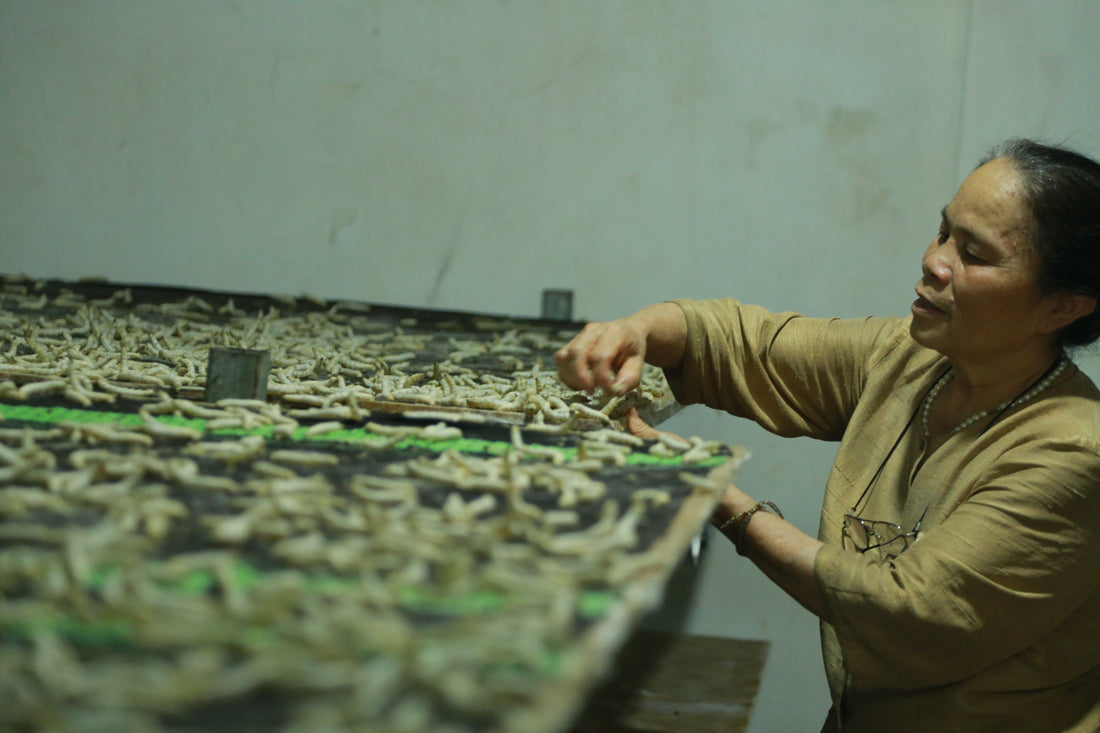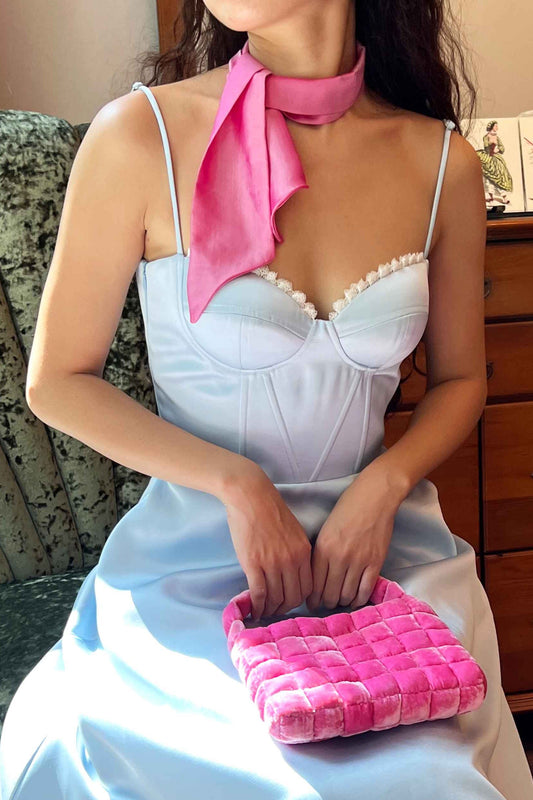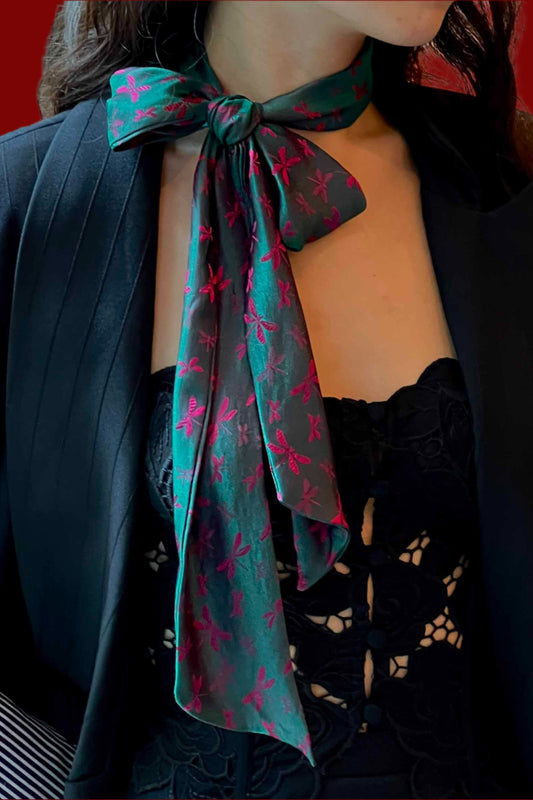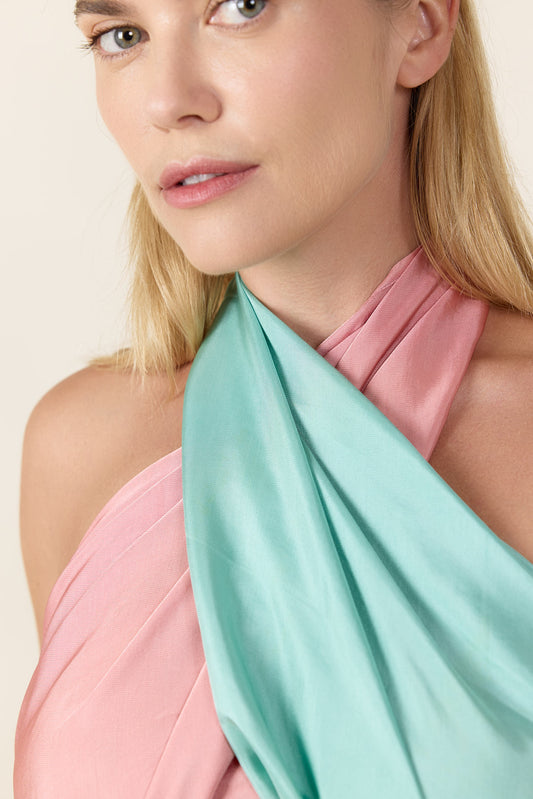Exploring the diverse world of Silk

Share
Beneath its soft and elegant appearance, silk holds a rich and varied universe of fabrics—each type woven using different techniques, resulting in unique textures, drapes, sheens, and tactile experiences. This article offers an overview of the most popular types of silk today and highlights the distinctive characteristics that set each one apart.
Mulberry Silk – A traditional fabric with timeless value
Silk is a luxurious fabric made from natural fibers such as mulberry silk, lotus silk, and others. Among them, mulberry silk is the most common and highly valued, thanks to its softness, natural sheen, and durability.
Unlike synthetic fibers, natural silk cannot be produced through industrial or chemical processes. It is usually woven by hand, using traditional techniques. As a result, creating a piece of mulberry silk fabric requires time, effort, and great attention to detail from skilled artisans.
-
Silkworm rearing stage
Silkworms are a type of caterpillar long known for producing one of the most precious natural fibers used in traditional silk weaving. They feed exclusively on mulberry leaves, and this specific diet has made them essential to sericulture (silkworm farming), a practice that dates back thousands of years. In ancient times, people called them "tằm" to distinguish them from harmful caterpillars.
To produce high-quality silk cocoons, both the silkworm eggs and the mulberry leaves must be carefully selected. Mulberry trees are typically grown in fertile soil, nourished with organic fertilizers, and watered naturally mainly with rainwater. These trees thrive in clean, unpolluted environments, ensuring healthy leaves that provide the best nutrition for the silkworms.
Silkworms are usually raised for 23 to 25 days before they begin spinning their cocoons. During this period, they consume a large amount of mulberry leaves due to their rapid growth and constant appetite. After their most active feeding stage, the silkworms stop eating and enter the cocoon-spinning phase.
-
Cocoon spinning stage
At this stage, silkworms behave like many other types of caterpillars. They look for a dry and safe place to spin their cocoons. When they are ready, farmers place them on a special frame where they can begin the cocooning process.
For about 48 hours, the silkworms release a long, thin thread made of protein from their saliva and wrap it around their bodies. Each worm can spin up to 1 kilometer of silk. Once the cocoon is finished, the silkworm stays inside and remains still for about 7 days while it transforms into a pupa.
This is the best time to collect the cocoons, before the silkworm turns into a moth and breaks the silk thread.
-
Silk reeling stage
This is a very important stage in the silk - making process that requires careful timing. Silk reeling means pulling the silk thread out of the cocoon. It must be done within about five days after the silkworm finishes spinning. If it's too late, the pupa inside will turn into a moth, break the cocoon, and damage the silk. In that case, the cocoon can no longer be used.
To reel the silk, the cocoons are soaked in hot water. This helps soften the natural glue that holds the silk layers together. After soaking, the silk threads are gently pulled out and twisted together to make stronger silk yarn. Usually, about 10 fine threads from 10 cocoons are combined to create one strong silk thread.
At this point, the silk thread is ready to be woven into fabric.
-
Silk weaving stage
Weaving is one of the most important steps in making silk fabric. This is when silk threads are woven together to form a complete piece of fabric. The thickness and quality of the silk depend on how closely the threads are woven. The thickness is often measured in a unit called momme.
There are many common weaving styles for silk, such as satin, plain weave, twill, and jacquard. Mulberry silk threads can also be blended with other natural fibers like linen, cotton, or raw silk to create different types of silk fabrics, such as silk-linen, silk-cotton, or silk-dui.
In basic weaving, threads go in two directions: vertical threads (warp) move up and down, while horizontal threads (weft) go side to side, crossing each other at right angles.
Today, machines can help weave silk faster and with fewer mistakes. However, handwoven silk still holds special value. Fabrics made by skilled artisans often have a unique beauty and fine craftsmanship that machines cannot replicate.
-
Dyeing stage
After weaving, natural silk has a soft white or ivory color, which comes from the silk fibers themselves. To create beautiful and colorful fabrics, the silk needs to go through the dyeing process.
In famous traditional craft villages like Nha Xa, Van Phuc, and Ma Chau, artisans still use natural dyes made from plants and herbs. Each village has its own special recipes and ingredients, which create unique colors. These natural shades often help buyers recognize where the silk comes from.
Besides natural dyes, people also use safe industrial dyes to meet modern needs for color variety and durability. Both methods aim to bring out the best in silk while preserving its beauty and quality.
Natural vs synthetic silk: What's the Difference?
|
Natural Silk |
Synthetic Silk |
|
|
Origin |
Mulberry silk comes from nature. It is made from the cocoons of silkworms. Producing this kind of silk is a traditional, time-consuming process that requires skill and care from experienced artisans. |
Synthetic fibers are made from chemical polymers, mostly derived from petroleum and other non-renewable resources. These materials are man-made and not found in nature. |
|
Characteristics |
Mulberry silk is a protein fiber that contains 18 types of amino acids. It can absorb moisture, reduce static electricity, and help regulate body temperature. This makes it cool in summer and warm in winter. |
Synthetic fibers are usually strong, wrinkle-resistant, and easy to take care of. However, they do not absorb moisture well, can feel stuffy, and are often less comfortable on the skin. |
|
Production Process |
It is made through natural processes like raising silkworms, reeling the silk, spinning the thread, and weaving the fabric. Each step requires skill and attention to detail. At GAMME, we are proud to use natural mulberry silk, staying true to tradition and the environment. |
This type of silk is produced through industrial and chemical methods. It often starts from raw materials like oil, coal, or cellulose from plants. Making synthetic fibers usually requires a lot of energy and can harm the environment. |
|
Care and maintenance |
Some natural fibers can shrink when exposed to water, so gentle care is needed. |
It is usually wrinkle-free, holds its shape well, and resists water, which makes it easier to store and maintain in humid environments. |
What makes each fabric feel different
-
Silk Satin
Satin silk is one of the most well-known types of silk. "Satin" actually refers to a weaving technique, not the fiber itself. It uses a special method where the threads are woven in a way that creates a smooth and shiny surface on one side, and a slightly rougher, dull surface on the other.
Depending on the type of silk thread used, satin can feel light or heavy, soft or slightly textured. When made from natural mulberry silk, satin keeps all the benefits of this high-quality fiber: it is lightweight, smooth, breathable, and comfortable to wear.
Satin silk feels cool in summer and does not cause static in winter. However, it can be difficult to sew, as it does not hold shape well and may show stitching mistakes easily. Because of its elegant look and feel, satin silk is often used for evening gowns, traditional dresses like áo dài or high-end daily wear.
-
Brocade Silk
Brocade silk is known as one of the most difficult and luxurious types of silk to produce. It is a thick, richly woven fabric, often made in vibrant colors like blue, pink, or green. The patterns on brocade are woven directly into the fabric, not printed or embroidered, which gives them a detailed, raised look that almost feels like hand embroidery on a satin base.
Depending on the weaving technique, the surface of brocade can show both flat and raised designs, adding depth and elegance. Some brocade fabrics feature many colors in one piece, such as five-color or seven-color brocade, making each fabric unique and eye-catching.
One special feature of brocade silk is how it reflects light, creating a shimmering, colorful effect when viewed from different angles. Because of its complexity and beauty, brocade is often called the "queen" of silk fabrics. Today, very few artisans still have the skill to weave traditional brocade by hand.
-
Twist Silk
Twist silk, also known as “double-faced silk,” is made by blending pure mulberry silk with shiny viscose fibers. When light hits the fabric, it creates a vivid, colorful shine that makes the patterns stand out clearly.
This fabric is smooth, soft, and wrinkle-resistant, with many rich patterns and textures. Thanks to the combination of materials, Twist silk offers both beauty and practicality. It is also affordable, making it suitable for a wide range of users.
One of its best features is its excellent ability to absorb dye, allowing for collections with bright, eye-catching colors and a wide variety of designs.
-
Twill Silk
Twill silk is made with a diagonal weaving pattern, which creates a fabric that is both strong and durable. Like satin, twill silk also has two different sides, but it is less shiny than texture making it suitable for more people. Thanks to its special weave, twill silk has a soft drape and a smoother, more structured feel. It is a great choice for making dresses, uniforms, office wear, and many other fashion items.
Twill silk combines comfort, strength, and elegance, making it a popular fabric in both casual and formal clothing.
-
Organza Silk
Organza silk is made by combining natural silk with synthetic fibers like nylon or polyester. It is designed to look and feel like raw silk, which is one of the most expensive types of silk on the market.
Normally, regular silk contains about 70% silk fiber and 30% natural gum (sericin). During processing, most of the gum is removed, leaving pure silk. However, raw silk keeps this gum layer, which gives it a crisp, slightly stiff Natural and a lightweight, airy feel, similar to paper.
Because true raw silk is now very rare and hard to find, organza was created as a modern alternative. It offers a similar look and structure, making it perfect for fashion designs that need volume and elegance.
In summary, different types of mulberry silk mostly vary by weaving style, fabric structure, and thread density. However, they all share one thing in common - a lightweight, smooth, and soft feeling on the skin.
We hope this article has helped you understand silk fabric more clearly. Try wearing silk pieces from gammeCollective to fully experience the elegance and beauty that only real silk can offer!




